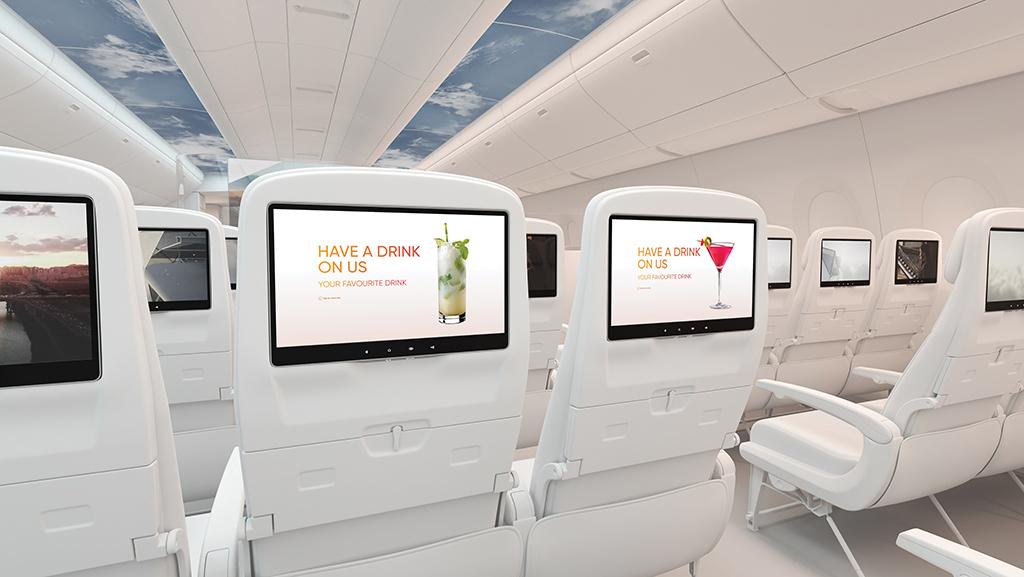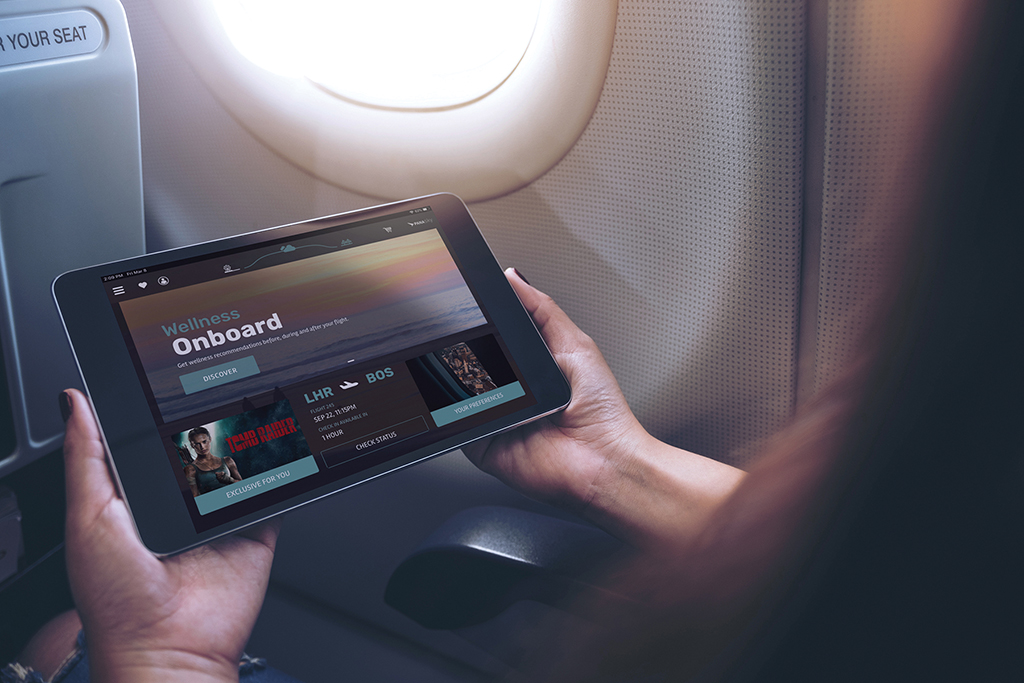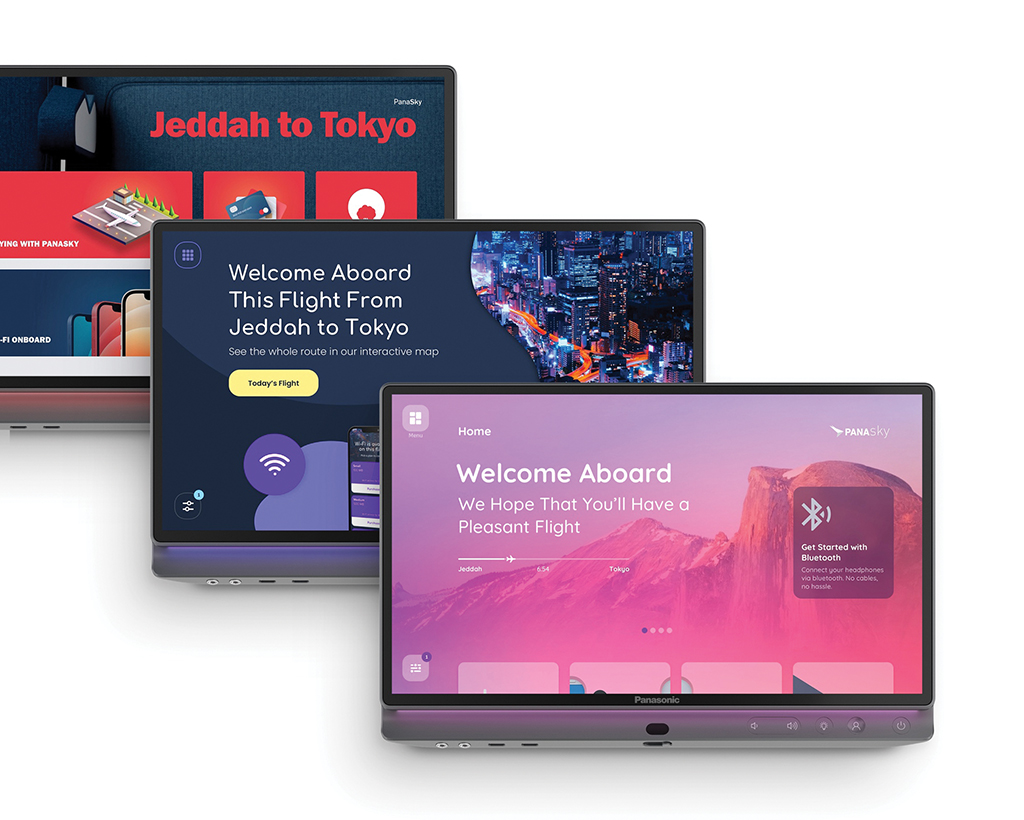
AERQ’s Aerena platform incorporates an open IT platform that uses cloud solutions, automated processes and virtual environments.
A new world of connectivity continues to displace legacy inflight entertainment content delivery and cabin communication systems as airlines become more attuned to passengers’ portable electronic devices.
“The cabin is becoming more connected to [personal electronic devices (PED)],” says Gary Weissel, managing officer of Tronos Aviation Consulting. “Many airlines are streaming their own content and require an app, but more systems and software development of newer systems are out there which use a web portal and do not require a separate app. We see this as the new trend, because consumers want to avoid loading apps they may not use regularly.”
Weissel also notes a continued trend toward Wi-Fi distributed content—locally or through internet connectivity. For internet/offboard connectivity, the focus remains on increasing speed through consistent upgrades. “Also, we continue to see some airlines move from air-to-ground to satellite connectivity as data pricing finally supports this trend,” he explains.
Ongoing satellite launches, increased satellite capacity and higher speeds for uploads and downloads, along with the proliferation of air-to-ground 5G systems, are enabling multidevice connectivity in the cabin, much the same as passengers experience in their homes or offices, Weissel points out.
Joshua Ng, director of Alton Aviation Consultancy, says that for cabin connectivity, passengers are expecting faster, cheaper and more reliable systems. He cites surveys by Inmarsat in 2022 and Panasonic in 2019 indicating that over 75% of travelers consider inflight Wi-Fi important. He notes that an increasing number of airlines are not only providing inflight Wi-Fi, but also starting to offer it for free.
“This trend emphasizes the growing significance of inflight Wi-Fi in the decision-making process of airline travelers,” Ng says. “Inmarsat’s survey also revealed that approximately 50% of travelers would be deterred from using inflight Wi-Fi if they had to pay for it or experienced slow and unreliable connections. As devices and apps become more data-intensive, the need for faster and more reliable inflight Wi-Fi is also increasing.
“In response to growing demand and as part of the process of fleet renewal, many airlines have begun to install or upgrade the current inflight Wi-Fi connectivity systems onboard their new-generation aircraft,” Ng continues. “The ability to connect to inflight Wi-Fi is slowly becoming a norm among the flying public. In addition, technology providers are launching more satellites and building more ground towers in order to increase the coverage and reliability of inflight Wi-Fi across the globe.”
For example, he notes that Qatar Airways has upgraded to Inmarsat’s GX Aviation’s broadband technology, allowing for an inflight Wi-Fi experience that is as fast and reliable as mobile Wi-Fi on the ground. “Industry groups, such as the Seamless Air Alliance, are bringing together airlines, OEMs and telecommunications service providers to build common standards and drive the next phase in cabin connectivity advancement,” he says.
Ng predicts improvements in satellite technology will be the main driver of improved cabin connectivity, since air-to-ground relies on land-based towers, making it useless for overwater, intercontinental flights.
He adds that the recent introduction of new low-Earth-orbit (LEO) or medium-Earth-orbit (MEO) satellites is likely to drive “the step change in inflight Wi-Fi performance” and offer a more seamless and similar experience to ground-based Wi-Fi, due to their improved latency, higher capacity and bandwidth. “That is why existing geosynchronous (GEO) satellite providers—such as Intelsat, Inmarsat, Via-Sat and SES—are designing hybrid, multi-orbit products, combining LEO/MEO and GEO systems for their next-generation inflight Wi-Fi and connectivity,” he adds.
Will the next step in cabin Wi-Fi allow airline passengers to connect with their wireless providers of choice? Ng says that for the moment, the answer is “no.”
“Due to the limited number of inflight Wi-Fi providers in the market today, airlines prioritize their own economic, operational and strategic considerations in the type of inflight Wi-Fi/connectivity system providers to go with,” he says. “Letting passengers connect with the wireless provider of their choice is not a priority at the moment—though we have seen trends where telecom providers have partnerships with various inflight Wi-Fi companies to allow subscribers to obtain discounted rates for onboard connectivity.”
Teddy Gil, chief administrative officer of Sheffield Aerospace, reports a trend toward a tiered connectivity approach, based on either a pay-for-service or high-end loyalty status, with the basic service free and very limited, or throttled back based on the tier. “For example, if a passenger is willing to pay or has a high loyalty status, they would be afforded a higher-speed connection with more options for accessing different sites and applications, including streaming,” he says.
Related to that, Gol says airlines are leveraging technologies to decrease the overall weight of the equipment supporting the customer experience.

“More connectivity design changes are being made to better accommodate PEDs, which is a focus point,” Gil says. “Since most everyone has a PED, harnessing their use would enable airlines to reduce the number of screens at each seat, which means hundreds of pounds of weight savings and reduced cost to carry this extra weight. I would not be surprised to see a drastic reduction in the number of seats with in-seat monitors.”
Ng is more cautious. While he notes that removal of seatback monitors generates savings in weight—as well as in hardware investment and overall maintenance—a sizeable number of airlines have retained them despite the economic concerns. For instance, he points out, less tech-savvy passengers may be less inclined to download a special app required to use the inflight entertainment (IFE) system. He cites a 2018 International Air Transport Association survey that revealed that 54% of passengers prefer seatback IFE, while 36% like to use their personal devices.
“Seatback IFEs have continued to be installed on an overwhelming majority of widebody aircraft that are typically used for flights over 5 hr.,” Ng says. He adds that seatback IFE likely will continue to be the way passengers receive airline-provided content. “The use of PED-based IFEs will retain some traction in the single-aisle segment but is unlikely to become the dominant way for passengers to receive airline-provided content.”
Cabin connectivity includes the potential for more than IFE, even though that may be in its very nascent stages, according to Weissel.
“There have been discussions of digitizing cabins and bringing more Internet of Things to aircraft cabins for years, but we’ve seen little progress,” Weissel says. In fact, he reports that some companies that manufacture the motors driving first- and business-class seat recline, leg rests and lumbar support have pushed for centralized (wired or Wi-Fi) units on the aircraft with which aintenance and cabin crew could interact to indicate when those systems are not working properly.
“The system would communicate that issue to a central computer that would alert the flight crew and maintenance staff and also provide troubleshooting suggestions,” Weissel says. “But so far, we haven’t seen wholesale acceptance by the market.”
Asked about the implementation of cabin connectivity with cabin management systems (CMS), Weissel points out that CMS are separate from passenger inflight entertainment and communication (IFEC) systems—at least for now. “I don’t see this changing in the near future, but it definitely is something longer-term we could see happening. OEMs want to standardize on the production line what they are offering,” he says. “Having a single solution for CMS and cabin connectivity would make sense from a standardization standpoint.”
However, Weissel stresses that there will be security concerns with tying the customer-accessed Wi-Fi system to the CMS. “IT security is becoming increasingly relevant the more connected aircraft and their systems become. And directly tying Wi-Fi into AC control systems is an area of concern,” he says.
Floris Reimbold, senior manager of business development at AERQ, a Hamburg-based IT platform provider, says the company’s Aerena system was developed as a baseline for a connected cabin. He says Aerena is a ground-based open IT platform, using cloud solutions, automated processes and virtual environments. As a system agnostic to technology and IFE provider, it will work with the airline’s choice of IFE systems.
“With just one login by the airline’s IFEC managers, Aerena allows them to control the digital cabin experience through instant onboarding of third-party apps, creating an ecosystem consisting of the airlines, its passengers and selected third parties,” Reimbold says. “This in turn offers airlines and their partners opportunities for revenue through advertising, destination services, onboard platform businesses and more.”
In addition, Reimbold says the app integration process is accelerated, making it possible for the apps and their content to be updated on demand, without fixed content cycles, thus increasing the airline’s flexibility and saving both time and costs.
Andy Masson, vice president of product and portfolio management for Panasonic Avionics, reports that the company is developing the infrastructure to work with the new multiple LEO/MEO satellite networks. This includes new terminal and software infrastructure as well as new portals for passenger log-in, while providing the airline with greater control, including changes in content and applications.
“It is about a more customized solution for the airline and greater passenger engagement with the airline throughout the flight, with more real-time applications for the passengers as well as the cabin crews,” Masson says. “As examples, those applications could focus on shopping, hospitality and credit card payments, using a mobile app or through an airline-hosted site, depending on the airline.”

Panasonic Avionics launched its Modular Interactive (MI) digital platform at last October’s APEX trade show in Long Beach, California.
Panasonic says MI focuses on airline needs for brand enhancement through direct communication with passengers in the context of different loyalty programs, flight themes and promotional offers, as a few examples. MI features a fully integrated IFE interactive design and publishing tool, giving airlines the capability to create easily implemented seatback interactive solutions and the freedom to change interactive layouts without additional software installation. Panasonic says an additional benefit is the platform’s elimination of the costly and time-consuming process of loading custom graphical user interface solutions.
